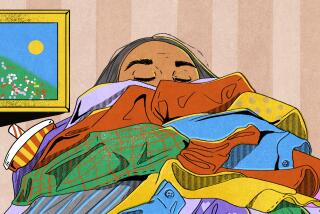For Compulsives, Home Is Where the Hoard Is
- Share via
Worried that your stash of 40-year-old National Geographics and those teetering towers of books mean you’re a hoarder with a problem, not the avid collector you’ve always considered yourself to be?
What about your mother, her basement crammed with 30-year-old statements from long-defunct banks, clothing that hasn’t been worn since the Eisenhower administration and the world’s largest collection of metal TV dinner trays, all of which she’s saving “just in case”?
Social worker Henriette Kellum says its as difficult to define true hoarding as it is pornography, but you know it when you see it. Even to the untrained eye, hoarding looks very different from messiness or collecting.
“People are always joking, ‘Oh, I’m a hoarder’ or, ‘You should see my house,’ ” says Kellum, coordinator of the senior adult mental health program in Arlington County, Va. “They don’t have a clue what hoarding looks like. I still remember the first time I saw it. I was in shock.”
The most widely accepted working definition of severe hoarding, promulgated by Smith College psychology professor Randy O. Frost and his colleagues, who study the problem, is the steady and often-compulsive acquisition of things that appear to be useless or of limited value, coupled with a failure to discard them. This accumulation makes it impossible to use living spaces for the purposes for which they were designed and causes distress or impairs functioning.
“One of the key differences between a hoarder and a collector is that a real collector acquires and discards,” says Michael Tompkins, a cognitive behavioral therapist in San Francisco who treats hoarders. “These collectors just acquire; they never discard.”
*
That means, for example, that having a lot of boxes of papers and books and other stuff stacked in your basement may not mean you’re a hoarder, unless you’ve had to make pathways through the clutter. If you can’t use your kitchen sink or oven because they’re serving as storage, you may have a problem. Ditto if you can’t sleep in your bed or eat at a table.
“Everyone collects things, and there are lots of people who engage in hoarding behavior who don’t have a problem,” Frost says. “For hoarding to be a clinical problem, there has to be chaos.”
In most hoarders’ homes, piles of unrelated junk--clothing, unopened bulk mail, newspapers, old porch furniture, leftover food--are mixed with valuables: envelopes containing cash, the deed to a house, cherished family photographs.
Infestation of insects or rodents or both is not uncommon, but their presence rarely bothers the hoarder. Sometimes other hazards are glaringly apparent, such as newspapers heaped on the burners of a stove.
In Frost’s view, this chaos underscores an important deficit: an inability to organize. To a hoarder, “a book is not a book. Each book belongs to its own specific category,” Frost noted, and is considered unique. It cannot be stacked on a shelf and grouped with other books, but must be put in a visible spot where it can be seen. That spot is often atop a pile of other stuff, all of which is considered to be of equal importance. Invariably the pile collapses.
*
People with serious hoarding problems also seem to have inordinate difficulty making decisions, a key component of organizing.
Hoarders often view their possessions as extensions of themselves, and many report that discarding seemingly ordinary items is painful. Hoarders are “generally much more attached to their stuff than other people,” says Jonnae Ostrom, a social worker in Orange County, Calif. “They love their stuff. They see potential in their stuff.”
In the vast majority of cases, severe hoarding also is characterized by an absence of distress. “They’re usually only ruffled when they’re forced to confront it,” says psychologist Charles Mansueto, director of the Behavior Therapy Center of Greater Washington. “I tell people it’s OK to have clutter and it’s OK to be messy, but it has to meet the building code,” says Alexandria, Va., social worker Deborah Warren.
More to Read
Sign up for our Book Club newsletter
Get the latest news, events and more from the Los Angeles Times Book Club, and help us get L.A. reading and talking.
You may occasionally receive promotional content from the Los Angeles Times.









